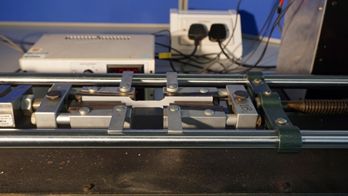Tensile test: force and extension
One of the most common ways in which the mechanical properties of a material can be assessed is through a tensile test.
'Tensile' means the sample has increased in length, i.e. extension, with a positive displacement. 'Compressive' means the sample has decreased in length, i.e. compression, with a negative displacement.
Here, a specimen is commonly cut into a 'dog bone shape', which gives a better grip at the end and a constant cross sectional area in the middle where it is stretched. The corresponding force and extension of the sample are recorded simultaneously. Such a test can continue until it reaches a predetermined point or until the material is unable to sustain the load and fails.

Figure 1: A tensometer with dog-bone sample loaded
You can investigate the mechanical behaviour of copper below, by adjusting the cross-sectional area and the length, and plotting force as a function of extension.
We can see that the behaviour measured by force and extension depends on the sample dimensions (cross-sectional area and length) of the samples. It is therefore more common to plot stress and strain instead, which translate force and extension to quantities independent of geometry.

